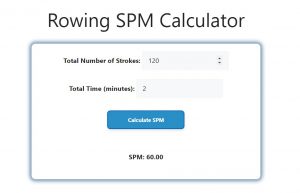About Rowing SPM Calculator (Formula)
Rowing is a demanding sport that requires precise technique and efficient stroke mechanics to achieve optimal performance. One essential metric in rowing is Strokes Per Minute (SPM), which measures the number of strokes a rower takes in a minute. Understanding your SPM can help you adjust your pace, improve endurance, and enhance overall rowing efficiency. In this article, we will explore the formula for calculating SPM, how to use the calculator effectively, provide an example, and address common questions related to rowing performance.
Formula
The formula for calculating Strokes Per Minute (SPM) is:
SPM = (Number of Strokes / Time) x 60
Where:
- SPM is the strokes per minute.
- Number of Strokes refers to the total strokes completed during the measured time.
- Time is the duration taken to complete those strokes, typically measured in seconds.
How to Use
- Count Your Strokes: Begin by rowing for a specific time period and keep track of the total number of strokes you complete.
- Measure the Time: Record the duration of your rowing session in seconds.
- Apply the Formula: Insert your values into the formula to calculate your SPM.
- Analyze the Result: Use the calculated SPM to gauge your rowing speed and efficiency, and adjust your training as necessary.
Example
Let’s say you completed 120 strokes in a time of 2 minutes (or 120 seconds).
Using the formula:
SPM = (Number of Strokes / Time) x 60
SPM = (120 / 120) x 60
SPM = 1 x 60
SPM = 60
In this example, your strokes per minute would be 60.

FAQs
- What is SPM in rowing?
SPM stands for Strokes Per Minute and measures how many strokes a rower takes in one minute. - Why is SPM important?
It helps rowers assess their pace and endurance, allowing them to optimize their performance. - How do I improve my SPM?
Focus on increasing your stroke rate through proper technique, fitness training, and consistent practice. - What is a good SPM for recreational rowers?
A typical range for recreational rowers is between 20 to 30 SPM, but it varies based on fitness levels and rowing style. - How does SPM affect rowing speed?
Generally, a higher SPM can lead to faster rowing speeds, but it must be balanced with stroke power and technique. - Can I use the SPM calculator for different rowing styles?
Yes, the calculator is applicable for all types of rowing, including sculling and sweep rowing. - What if I row for longer durations?
For longer rows, focus on maintaining a steady SPM for consistency and efficiency. - How do I measure the time accurately?
Use a stopwatch or a rowing machine with a built-in timer to measure your time accurately. - Is it better to have a higher or lower SPM?
It depends on the context; a balance between SPM and stroke power is essential for effective rowing. - Can I calculate SPM without a rowing machine?
Yes, you can count your strokes and measure time on water or any other rowing setup. - Does SPM vary with rowing conditions?
Yes, water conditions, boat type, and weather can all affect SPM. - What role does technique play in SPM?
Proper technique is crucial for maximizing SPM while maintaining power and control. - How can I track my SPM over time?
Keep a training log to record your SPM and monitor your progress. - Is there a recommended SPM for competitive rowers?
Competitive rowers often aim for higher SPM, typically around 30 to 40 SPM, depending on their race strategy. - What training methods can help increase my SPM?
Interval training, technique drills, and strength conditioning can help improve your SPM. - How does fatigue impact SPM?
Fatigue can decrease SPM; it’s important to pace yourself during longer sessions. - Can SPM be affected by equipment?
Yes, the type of rowing boat and oars can influence your SPM due to differences in weight and drag. - What is the relationship between SPM and stroke length?
Higher SPM may lead to shorter strokes, while a lower SPM often corresponds with longer, more powerful strokes. - How do I set SPM goals?
Set realistic goals based on your current fitness level and gradually increase them as you improve. - Is it beneficial to cross-train for rowing?
Yes, cross-training can enhance overall fitness, strength, and endurance, contributing to improved SPM.
Conclusion
The Rowing SPM Calculator is a valuable tool for any rower looking to enhance their performance. By understanding and applying the formula SPM = (Number of Strokes / Time) x 60, you can gain insights into your rowing efficiency and make informed adjustments to your training. Whether you’re a beginner or a seasoned athlete, tracking your SPM can lead to significant improvements in your rowing technique and overall performance on the water.